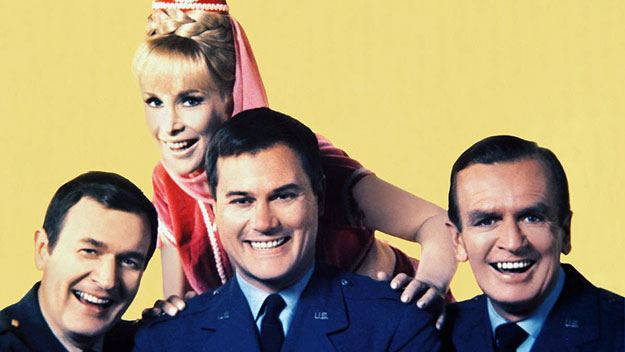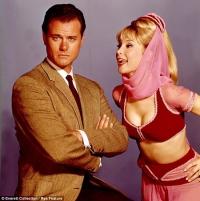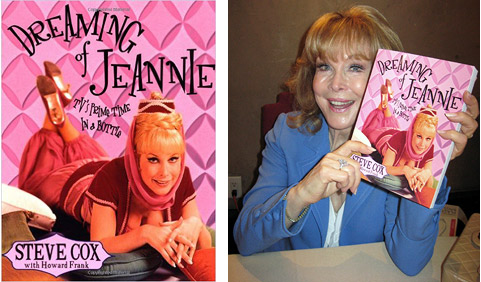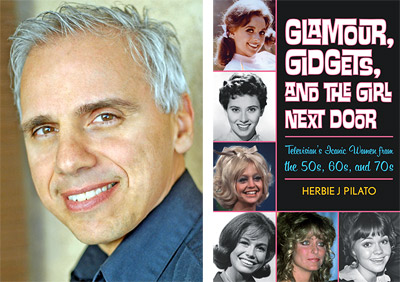The classic series, which also featured Bill Daily and Hayden Rorke in memorable supporting roles, premiered 50 years ago this week, and for the occasion The Bits features a Q&A with a trio of classic television historians and authors, who offer their recollections and insight into the popular series.
The Q&A participants…
Steve Cox is the author (with Howard Frank) of Dreaming of Jeannie: TV’s Prime Time in a Bottle (St. Martin’s Press, 2000). He has written more than 20 books on pop culture, movies and television, including One Fine Stooge: Larry Fine’s Frizzy Life in Pictures (co-authored with Jim Terry, Cumberland House, 2006), The Munchkins Remember: The Wizard of Oz and Beyond (E.P. Dutton, 1989), The Beverly Hillbillies: A Fortieth Anniversary Wing Ding (Contemporary Books, 1988; revised edition HarperCollins; third edition Cumberland House, 2002), The Addams Chronicles: An Altogether Ooky Look at the Addams Family (Cumberland House, 1998), The Munsters: A Trip Down Mockingbird Lane (Watson-Guptill/Backstage Books, 2006), Here’s Johnny!: Thirty Years of America’s Favorite Late-Night Entertainer (Crown Books, 1992; revised edition Cumberland House, 2002), and The Hooterville Handbook: A Viewer’s Guide to Green Acres (St. Martin’s Press, 1993). He has also written for TV Guide, The Hollywood Reporter, US, Los Angeles Times and St. Louis Post-Dispatch. Steve is currently working on Bedrock Babylon: Unearthing the Flintstones.
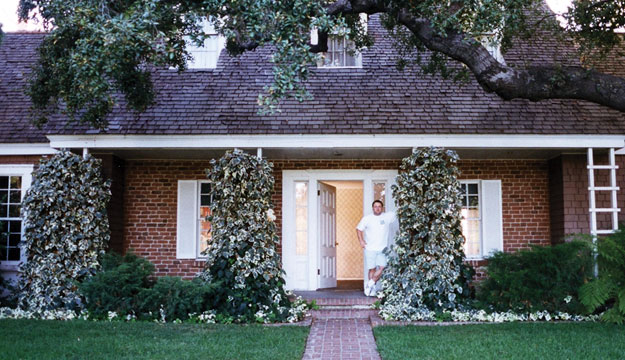
Judy Moore helped organize the I Dream of Jeannie 50th anniversary celebration event and is the author of the forthcoming I Dream of Jeannie History Book.
Herbie J Pilato is the author of Glamour, Gidgets, and the Girl Next Door: Television’s Iconic Women from the 50s, 60s, and 70s (Taylor Trade Publishing, 2014). The writer, producer, lecturer and consultant has also penned The Bewitched Book (Delta, 1992), Bewitched Forever: The Immortal Companion to Television’s Most Magical Supernatural Situation Comedy (Tapestry, 1996; and updated in 2004), Twitch Upon a Star: The Bewitched Life and Career of Elizabeth Montgomery (Taylor Trade Publishing, 2012), and The Essential Elizabeth Montgomery: A Guide to her Magical Performances (Taylor Trade Publishing, 2013). Herbie’s other books include The Bionic Book: The Six Million Dollar Man & the Bionic Woman Reconstructed (Bear Manor Media, 2007) and NBC & Me: My Life as a Page in a Book (Bear Manor Media, 2008). He heads the production company Television, Ink., and was a consulting producer on the DVD season sets of Bewitched, CHiPs, Kung Fu and The Six Million Dollar Man.
The interviews were conducted separately and have been edited into a “roundtable” conversation format.
Michael Coate (The Digital Bits): In what way is I Dream of Jeannie worthy of celebration on its 50th anniversary?
Steve Cox: I think all shows of the 60s—especially the zany brand—deserve commemoration on their anniversary. I’m sure Barbara Eden and Bill Daily, the lone main cast survivors, would attest that the time went much too quickly and they find it hard to believe it’s been that long since the pilot of I Dream of Jeannie premiered. But for nothing else, the show has maintained a loyal following and picked up new generations of “bottle babies,” so there is something to be said for longevity of a fun show like this one. After all, it wasn’t the most expensive show or even the highest rated at the time, but it sure packed some power.
 Judy Moore: I Dream of Jeannie is a feel good show that has lasted fifty years, and hopefully, will last that much longer and beyond. Fans that have faithfully followed I Dream of Jeannie want to celebrate their journey of watching a show that is connected with a very powerful part of our American and world history, that is, the journey to the moon. As the characters of Tony Nelson, Jeannie, and Roger Healey, became friends, we followed right along as the astronauts trained for their missions, despite Jeannie’s well-intentioned interference, while the real astronauts fulfilled their dreams. I Dream of Jeannie has “the right stuff.”
Judy Moore: I Dream of Jeannie is a feel good show that has lasted fifty years, and hopefully, will last that much longer and beyond. Fans that have faithfully followed I Dream of Jeannie want to celebrate their journey of watching a show that is connected with a very powerful part of our American and world history, that is, the journey to the moon. As the characters of Tony Nelson, Jeannie, and Roger Healey, became friends, we followed right along as the astronauts trained for their missions, despite Jeannie’s well-intentioned interference, while the real astronauts fulfilled their dreams. I Dream of Jeannie has “the right stuff.”
Herbie J Pilato: Like Bewitched, which came before it, I Dream of Jeannie speaks to a grand wish-fulfillment aspect in us all. The series has not been off the air for one second since its debut, and it remains imbedded in the psyche of American pop-culture.
Coate: Can you recall when you first saw the show?
Cox: I vividly remember being instantly drawn to the theme song and the animation (what kid didn’t love cartoons?) when it reached full bloom syndication in the 1970s. I grew up in St. Louis and an independent station aired the sitcom sometime in the afternoons, after school. The magic pulled me in, just like its sister show, Bewitched. The use of magic, sound effects, and a great cast simply cast a spell on this young viewer. I think it appealed to different people for different reasons. Some young teenage guys watched—I mean, let’s face it—because of Barbara Eden’s ample cleavage. Others, interested in NASA and the space program might have been drawn to that part of the storyline. I’ve heard from some fans who adored the bottle and everything it contained. There is a variety of powers that show held over viewers.
Moore: I have definite memories of watching the show during its original run, thereby dating myself. I watched what my family watched, so I’m glad that at a very young age they were interested in I Dream of Jeannie. Having grown up with the show, I realized that the way I viewed the series changed as I grew older. As a child, I enjoyed the magical aspect, as a teen the intriguing tango of Jeannie and Tony’s romance pulled me in, and as an adult I now watch in appreciation of the talented cast and crew, so much so, that I am compelled to write a book about the show.
Pilato: I actually remember watching the series for the first time during its initial network run on NBC, in its final season, which was from 1969-1970—and which was the year that Jeannie married Tony Nelson. After that I, like millions of other viewers, became addicted to the series in syndicated reruns, which were broadcast in the afternoons, after then-young kids like myself were glued to what we used to call “TV sets”!
Coate: Where do you think I Dream of Jeannie ranks among 1960s era TV shows?
Cox: Jeannie is not on top, but certainly not amongst the bottom selections. Maybe in the middle. I say that because it never reached phenomenal status by way of ratings or publicity, but it kept on going for longer than some of the most popular zany shows of the day, like Gilligan’s Island, The Munsters, Addams Family and even Lost in Space. That it’s remembered so fondly today is certainly a testament to its longevity. For every Jeannie and Gilligan, there’s a half-dozen other wacky 60s gimmick shows that aren’t remembered. How much of a fan base is there today for Captain Nice, My Living Doll or Camp Runamuck?
Moore: The 60s were a magical time for television, full of creativity, whimsy, and the brand new color. I Dream of Jeannie was contemporary to the 60s era. If anyone wants to know how to dress in 60s style, the show is a fine example. As an audience, we were on overload with the myriad of wonderful shows at our fingertips, however, we couldn’t record or download the shows as we can today. We had to make choices and ratings were important. With the tough competition, such as Get Smart, watching I Dream of Jeannie was often reserved for viewing in summer reruns. Despite the competition, during a very tumultuous time, I Dream of Jeannie hung in there for five years, notably, until man finally landed on the moon. Soon after, the show exploded in syndication, and those folks who put off watching the show during its original run finally had a chance to catch up.
Pilato: I Dream of Jeannie remains one of TV’s most popular shows from the 1960s…it hearkens back to a simpler time, even it was originally broadcast in one of the most tumultuous eras in American history. And yet, that’s just why the series is significant. I Dream of Jeannie offered a magical escape to mayhem created by the Vietnam War, race rioting, and horrific political assassinations.
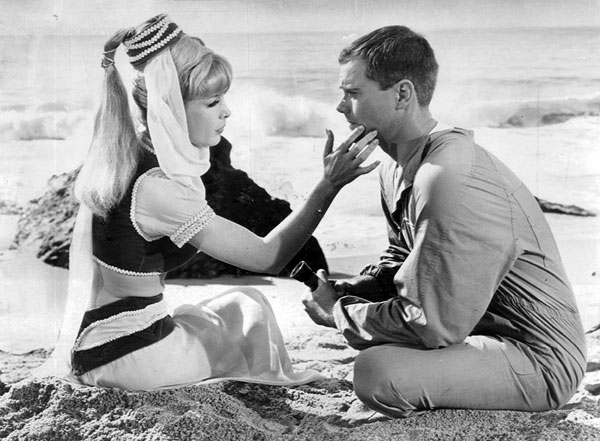
Coate: Which episodes are among your favorites?
Cox: In no order of importance, I love the Hawaiian episodes, the Paul Lynde episode, the Jim Backus guest-starring show, and any episode which showed Jeannie inside the bottle. I loved the physical comedy that Larry Hagman had to perform. (I complimented him on his ability to pull off some mighty challenging physical comedy during the episodes—it was something he wasn’t used to. Maybe that’s why Larry warmed up to me in the beginning and gave me a great interview for my book. I think he appreciated the fact that someone finally recognized some of his adept moves in the show.) And finally, I love the episodes where Jeannie appears with an oversized prop such as the giant coffee cup or pencil holder. Those steroidal, larger-than-life objects that the prop department built were magnificent.
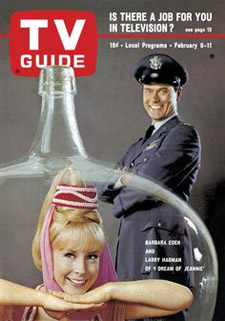 Moore: My favorite episode is from season one called The Moving Finger. Very dramatically, Jeannie tries to prove she can compete with any modern woman, especially to please her Master, but learns the hard way that she truly is, just a genie. My favorite comedic episode is Abdullah, the timing between Larry Hagman and Bill Daily is fabulous.
Moore: My favorite episode is from season one called The Moving Finger. Very dramatically, Jeannie tries to prove she can compete with any modern woman, especially to please her Master, but learns the hard way that she truly is, just a genie. My favorite comedic episode is Abdullah, the timing between Larry Hagman and Bill Daily is fabulous.
Pilato: My favorite episode is the pilot, where Major Nelson finds Jeannie on the beach. The charm and wonder of that initial segment so perfectly lays the foundation for the rest of the series. Other favorite episodes include Genie, Genie, Who’s Got the Genie? in which Jeannie gets locked in a safe, which was a multi-part episode, and any episode when Jin-Jin, the genie dog, literally popped into the picture!
Coate: Which are the ideal episodes to introduce to someone who has never seen the show?
Cox: My thought would be to introduce the show with the pilot so the show’s trajectory is set and the viewer has some idea where things will be going. Then I’d flash forward to the color episodes. I’ve always been more fond of the second and third season because the characters’ personalities and quirks were more cemented. Barbara Eden was more free-flowing with her character and a bit more comfortable within her own body—you might say. Larry Hagman, I know, was growing increasing more annoyed with the scripts as the show went on, but it only served him and his pal Bill Daily to add new bits of material on their own. I remember Hagman telling me that as the show progressed, one of the most annoying things to try to overcome was being handed a script that was dead on its feet. Hagman had to remind Daily, “C’mon, Bill, this is MOVING pictures. We need to move, we need to do some things here, get moving around and put in some business.” I think the director in Hagman was trying to escape and gain employment at the time. And eventually he did.
Moore: To understand the premise, definitely the pilot episode, The Lady in the Bottle, and My Hero also from the first season is just lovely and fun! How to be a Genie in 10 Easy Lessons from season two is a wonderful lesson on acceptance. Of course, The Wedding from the last season is the most beautifully filmed, and Barbara Eden and Larry Hagman make a stunning couple.
Pilato: Once more, I will mention the pilot. Even though the show did not yet fully come into its own, and the characters were still not fully-shaped and developed, it’s one of the finest half-hour pilots ever created, right alongside the pilot for Bewitched.
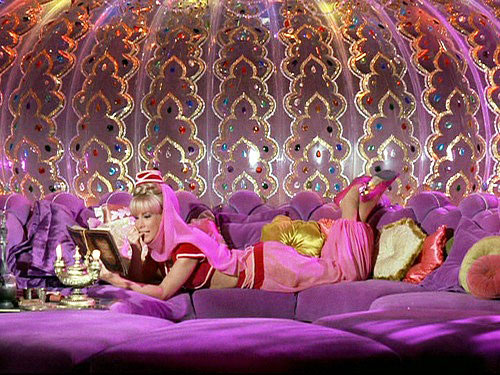
Coate: Do you prefer the black-and-white episodes or the color episodes?
Cox: Undisputed. This fan’s (and most fans’) favorites are the color episodes. Jeannie was made for color in every way. Once the transition was made, there were changes among the sets, the look, the lighting, the costumes and even Eden’s makeup and hair—all to accentuate the new color. And thank God they went to color [after the first season]. They were one of the last to do so on NBC, a network which held back until they no longer could.
Moore: All of my television experiences back then were in black-and-white as our color television didn’t arrive until 1969 when the series was nearly finished. I only knew Jeannie wore pink from seeing photographs in TV Guide. Absolutely, I love the first season black-and-white episodes. Many of those episodes were directed by Gene Nelson, an actor/dancer, whose influence resulted in a lot of movement in the episodes. For example, bottles flew and twirled, Jeannie jumped expansively from a chair into her bottle, couples danced, and Jeannie and Tony floated in the air. Some of the episodes were almost like mini-movies. Though the color episodes were vibrant, the black-and-whites were classic.
Pilato: There was a different quality to the black-and-white episodes as opposed to the color segments. They weren’t better or less-than, but just different. As such, having the first season in black-and-white, and the remaining four years in color, adds another appealing element to the series…even though certainly the color episodes lent more to the special effects “magic” on the show.
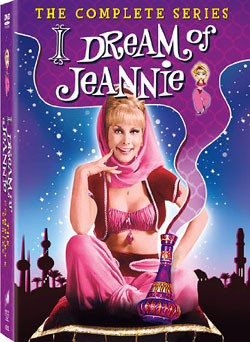 Coate: What are your thoughts on the DVD season sets of the series?
Coate: What are your thoughts on the DVD season sets of the series?
Cox: While I love the color and the terrific transfers from the masters—the episodes never looked better!—there was a lack of supplementary materials and bonus features which Sony could have enhanced the box set with. A little documentary would have been nice. What I was greatly disappointed in was the commentary by Eden, Hagman, and Daily. In their defense, none of the three had ever recorded a DVD commentary and they really didn’t know what they were doing. They needed a moderator—I would have loved to have done it if I was asked… but I wasn’t—someone who would have gently pulled them through the episode and asked the proper questions, prompting memories from the cast at the same time. Unfortunately, as it turned out, the commentary included long periods of silence and when Barbara Eden did comment, all she would say is “Oh, Larry, you were so cute back then.” I wanted to pull my hair out. I thought, “Sony hired these three and got them into a studio to watch some episodes and this is what came out of the experience? “Larry, you were so cute back then?”—incredibly disappointing. It would have been enormously better with a moderator asking the questions the fans want answered.
Moore: I love having the series on DVD. This allows me to scrutinize the details of production, to see aspects I might have missed before. They are especially helpful for my book, and I’m happy to say I’ve nearly worn out one whole set of DVDs.
Pilato: I’m just delighted that the series, like so many classic TV shows, is made available for original and new fans who are discovering the series for the first time.
Coate: Would you like to see the series get released on Blu-ray Disc?
Cox: Most definitely, but only if they go back to the masters and original 35mm elements and remaster in high definition from the original materials for the Blu-ray presentation. As it is, I think the clean transfers shown in the recent series release is magnificent quality, a Blu-ray could only enhance the quality. The colors would really pop, I’m sure!
Moore: Absolutely, as technology moves on, I Dream of Jeannie will move on too.
Pilato: Absolutely!
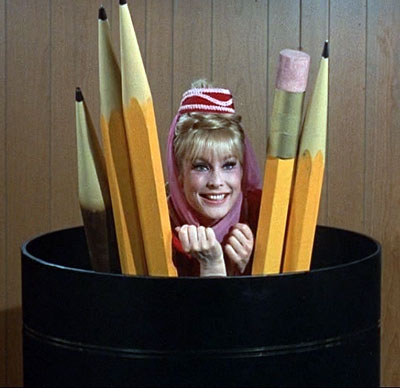
Coate: What are your thoughts on the follow-up shows (animated series, TV movies, etc.)?
Cox: I found the TV reunion movies nice, cute little augmentations to the series, but I hated the fact that Hagman was not associated with the projects. It was nice to see Rorke and Daily and Eden in the first and that was a nearly complete ensemble. It worked for me and it was produced at the right time before anyone began to look too old to pull it off. Somehow, I got the feeling that Larry Hagman never felt any regret for not doing those. Even though he eventually warmed up and toured doing publicity for the show and made appearances at nostalgia shows with Eden and Daily—enjoying the experience (and the money!)—Hagman separated that from those reunion movies. He did like hearing that the show was recognized as “classic.” That was music to his ears, it really was. He loved feeling that the series was something of substance and importance among fans. And not necessarily the critics—mainly the fans.
Moore: I also watched the animated series originally in the early 1970s, and once I realized the show was different from the live prime-time Jeannie, I enjoyed it. I felt the same with the movies, again acceptance. At first, I was puzzled with the differences, upset in fact, but then all of these years later, I re-watched the movies and thoroughly enjoyed them.
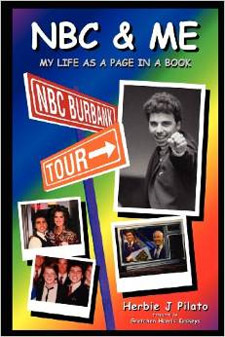 Pilato: The animated series was quite different than the original live-action series. For one, Jeannie had red hair, as opposed to Barbara Eden’s blonde locks. And the mortal male character, though he had dark hair, had nothing to do with Major Anthony Nelson. So, I’d almost classify the show as almost another Jeannie universe altogether, as opposed to even a remake or a sequel…. As to the Jeannie TV-reunion movies of the 1980s, I was honored to have actually worked on the publicity for the first film, I Dream of Jeannie…Fifteen Years Later, which was produced by NBC, when I worked as a page for the network. Ironically enough, that film was directed by William Asher, the producer/director of Bewitched, which was a nice tie-in, as Bewitched had originally inspired I Dream of Jeannie in the first place. As Bewitched creator Sol Saks once told me, NBC had originally approached him about creating another witch, this time for their network, as he did with Bewitched for ABC. But he turned down their offer, and that’s when NBC went to Sidney Sheldon, who went on to create a genie. The further irony here is that Sheldon and William Asher were good friends who had worked together previously on The Patty Duke Show. So, when Sheldon was approached by NBC, he went to Asher and asked if he minded he did a show about a genie, as opposed to a witch. And Bill didn’t care. Sheldon then wondered how he would have Jeannie manifest her magic like Samantha did with her nose. And the genie eye-blink was then born, inspired once more by Bewitched, and specifically by the Samantha nose-twitch. With specific regard to I Dream of Jeannie…Fifteen Years Later, the film became not only the highest-rated TV-movie of 1985, but it went on to become one of the highest rated TV-movies of ALL TIME…despite the lack of Larry Hagman’s presence, who opted not to do the film. He was sorely missed, and Wayne Rogers, simply could not fill his mortal shoes. Thankfully, Bill Daily and Hayden Rorke reprised their beloved roles from the original series. A few years later, a second TV-movie, Still Dreaming of Jeannie, proved a further success… and, of course, Barbara Eden shined her beautiful magic in both films!
Pilato: The animated series was quite different than the original live-action series. For one, Jeannie had red hair, as opposed to Barbara Eden’s blonde locks. And the mortal male character, though he had dark hair, had nothing to do with Major Anthony Nelson. So, I’d almost classify the show as almost another Jeannie universe altogether, as opposed to even a remake or a sequel…. As to the Jeannie TV-reunion movies of the 1980s, I was honored to have actually worked on the publicity for the first film, I Dream of Jeannie…Fifteen Years Later, which was produced by NBC, when I worked as a page for the network. Ironically enough, that film was directed by William Asher, the producer/director of Bewitched, which was a nice tie-in, as Bewitched had originally inspired I Dream of Jeannie in the first place. As Bewitched creator Sol Saks once told me, NBC had originally approached him about creating another witch, this time for their network, as he did with Bewitched for ABC. But he turned down their offer, and that’s when NBC went to Sidney Sheldon, who went on to create a genie. The further irony here is that Sheldon and William Asher were good friends who had worked together previously on The Patty Duke Show. So, when Sheldon was approached by NBC, he went to Asher and asked if he minded he did a show about a genie, as opposed to a witch. And Bill didn’t care. Sheldon then wondered how he would have Jeannie manifest her magic like Samantha did with her nose. And the genie eye-blink was then born, inspired once more by Bewitched, and specifically by the Samantha nose-twitch. With specific regard to I Dream of Jeannie…Fifteen Years Later, the film became not only the highest-rated TV-movie of 1985, but it went on to become one of the highest rated TV-movies of ALL TIME…despite the lack of Larry Hagman’s presence, who opted not to do the film. He was sorely missed, and Wayne Rogers, simply could not fill his mortal shoes. Thankfully, Bill Daily and Hayden Rorke reprised their beloved roles from the original series. A few years later, a second TV-movie, Still Dreaming of Jeannie, proved a further success… and, of course, Barbara Eden shined her beautiful magic in both films!
Coate: What is the legacy of I Dream of Jeannie?
Cox: This is the toughest question today. What IS the legacy? I guess it’s what every fan makes of it. And it’s still on-going, at least as long as Barbara Eden is alive and gorgeous and amenable to appearing before audiences, never tiring of talking about her magical alter ego. Will the show simply poof out like a burst of pink smoke one day and never be heard from again? I don’t think so. There are too many fans still discovering the show and dissecting it and loving it. And ultimately, I hope the legacy of Jeannie will include a revised edition of my book published by St. Martin’s Press. I have kept an open file on the show and have amassed quite a collection of rare and unseen materials regarding the show—including interviews with personnel and crew from the show who have never opened up about their work on the show until now. Larry Hagman even provided some interesting comments intended exclusively for a revised edition. I hope I can sell it to a publisher! I’m confident.
Moore: I Dream of Jeannie will be around a long time as the show is timeless. The characters are so handsome and likeable, and one hopes the best for them. The costumes (Tony’s uniform and Jeannie’s harem costume) are unique in that they never seem to age and certainly apply to today by their inspired design. Though the show primarily focused on an astronaut and a genie, the legacy is that I Dream of Jeannie is multi-layered and entertains on many levels. Basically, the show is about love, ambition, and acceptance, and it’s also educational by closely following the space program. I’m not sure any other show did this, so in that aspect, a fictional show following real events with a real conclusion is groundbreaking, at least for the time.
Pilato: The legacy of I Dream of Jeannie is true love…and that real love has the power to create real magic!
Coate: Thank you, Steve, Judy and Herbie, for participating and sharing your thoughts on I Dream of Jeannie on the occasion of its 50th anniversary.
---
- Michael Coate
